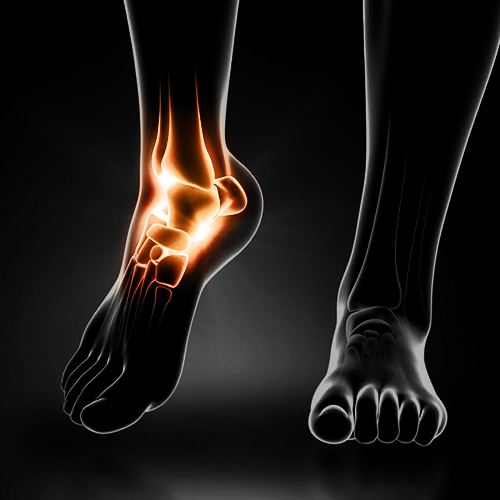
Foot and ankle injuries are among the most common injuries people experience, especially after an accident. Whether from a car crash, slip-and-fall, or other traumatic incidents, these injuries can significantly affect one’s ability to move freely and live without pain. At Accident and Injury Rehab Center, we understand the physical and emotional toll an accident-related foot injury can take. We offer specialized medical treatment to address a wide range of foot injuries caused by accidents, using advanced treatment techniques to promote healing and restore mobility.
If you suspect a foot fracture, seeking immediate medical attention is important. The earlier the injury is diagnosed, the faster you can begin appropriate treatment to minimize complications and support healing. Left untreated, it can lead to long-term issues, including chronic pain, misalignment of the bones, or arthritis.
When you visit a healthcare professional, you will likely undergo imaging tests such as X-rays to confirm the fracture and determine its severity. Depending on the fracture type, treatment options may range from conservative methods like rest, ice, and elevation to more invasive procedures like surgical realignment and casting.
Foot fractures can often be recognized by symptoms such as:
If you suspect a fracture, seeking immediate medical attention is essential. Early intervention can prevent complications and promote faster recovery.





Foot and ankle injuries can range from mild to severe, affecting your ability to walk and move comfortably. Understanding the various types of injuries that can occur is the first step in getting the proper treatment. At Accident and Injury Rehab Center, we treat a wide range of foot and ankle injuries, and below are some of the most common types we help manage:
Sprains and strains are among the most common injuries to the foot and ankle. A sprain involves the stretching or tearing ligaments, the tough bands of tissue that connect bones. A strain, on the other hand, refers to an injury to a tendon or muscle, typically caused by overstretching or excessive force.
These injuries often occur when the foot or ankle is twisted or turned in an unnatural direction due to sudden movements, falls, or trauma. Symptoms include pain, swelling, bruising, and limited mobility in the affected area. Severe sprains may cause the ligaments to tear, resulting in significant instability in the ankle joint. Strains can lead to muscle weakness and difficulty walking.
A fracture is a broken bone that can occur in any of the bones in the foot or ankle. Fractures typically result from a traumatic event such as a fall, car accident, or direct impact. Common fractures include breaks in the metatarsals (the long bones of the foot), tibia or fibula (the bones in the lower leg), and the ankle joint.
A foot or ankle fracture symptoms include severe pain, swelling, and bruising. Sometimes, a visible deformity, such as an abnormal angle or protrusion of the bone, is present. In some cases, fractures can make moving or bearing weight on the affected foot difficult, requiring immediate medical attention.
Plantar fasciitis is a common condition involving inflammation of the plantar fascia, a thick band of tissue that runs along the bottom of the foot from the heel to the toes. It typically causes sharp, stabbing pain in the heel, particularly when taking the first steps in the morning or after prolonged periods of standing or walking.
Plantar fasciitis is primarily caused by overuse, especially in individuals who spend long hours on their feet or engage in high-impact activities like running. Improper footwear, poor foot mechanics, and tight calf muscles can also contribute to the development of plantar fasciitis. Treatment typically involves rest, ice, physical therapy, and, in some cases, orthotics or anti-inflammatory medications.
Achilles tendonitis is inflammation of the large tendon that connects the calf muscles to the heel bone. It is commonly caused by overuse. However, it can also develop due to sudden strain or poor tendon flexibility.
Achilles tendonitis symptoms include pain and stiffness in the back of the heel, which may worsen with activity. The area may become swollen and tender, and in some cases, a visible lump can form along the tendon. Early treatment for Achilles tendonitis includes rest, ice, anti-inflammatory medications, and physical therapy to improve flexibility and strength. In severe cases, surgery may be required to repair tendon damage.
A stress fracture is a small crack in a bone, often caused by repetitive pressure or overuse. Stress fractures often affect the metatarsals (the long bones in the foot) but can also occur in the ankle.
Symptoms of a stress fracture include localized pain that worsens with activity and improves with rest. The area may become swollen and tender, but stress fractures are typically not visible on the surface. These fractures can be challenging to detect early, so proper diagnosis through imaging tests, like X-rays or MRI scans, is essential. Treatment typically involves rest, avoiding weight-bearing activities, and sometimes, using a walking boot or crutches.
Bunions and hammertoes are structural issues that affect the bones and joints of the feet, often causing pain and discomfort.
Both conditions are treated conservatively, such as wearing properly fitted shoes, using padding or orthotics, and performing foot exercises. In more severe cases, surgical correction may be necessary to realign the affected joints.
With over 5 decades of collective experience, our staff brings a wealth of wisdom and insight to your injury treatment and medical documentation that supports your legal claim. Our experience and caring approach allows us to provide thorough treatment to address your injuries and get you on the road to recovery.
Double Board Certified Chiropractic Neurologist and Chiropractic Internist
Doctor of Physical Therapy
Chiropractic and Radiological Technician
Foot and ankle injuries are common after various types of accidents and traumatic events. The foot and ankle are intricate structures composed of bones, ligaments, tendons, and soft tissues, making them susceptible to various injuries. Whether due to a car accident, a slip-and-fall, or any other traumatic incident, these injuries can severely impact your ability to move and perform daily activities. Here’s a deeper look at how foot and ankle injuries can occur, especially in the context of accidents:
Falls are among the most common causes of foot and ankle injuries, especially when people lose their balance or suddenly slip. Whether they trip on an uneven surface, slip on a wet floor, or lose their footing due to poor visibility or distractions, falls can lead to various injuries, including sprains, strains, and fractures. A sudden fall can put excessive pressure on the ankle or foot, causing the ligaments or bones to become overstretched or even fractured.
If you’ve fallen and suspect a foot injury, you must seek immediate medical attention to assess the severity and avoid further complications, such as chronic pain or long-term instability.
Foot and ankle injuries are incredibly common in car accidents, particularly when the vehicle experiences a sudden impact or collision. In a car crash, the foot may be trapped under the pedals or the dashboard, leading to fractures, dislocations, and soft tissue damage.
Assessing potential injuries immediately after a car accident is vital, even if the pain is not immediately apparent. Many injuries, especially fractures or ligament tears that could affect long-term mobility, can worsen if left untreated.
Injury from overuse or repetitive stress is common in activities involving repetitive movements, such as running, jumping, or prolonged standing. Repeated stress on the foot and ankle can cause small bone microfractures or inflammation in the tendons and ligaments.
If you experience persistent pain or discomfort in your foot or ankle due to repetitive activity, it’s crucial to rest, seek medical evaluation, and potentially modify your activity level to prevent further injury.
Wearing shoes that don’t provide proper support or fit properly can contribute to a wide range of foot and ankle injuries. In the context of an accident, improper footwear can make the foot more vulnerable to injury during a fall or impact.
When recovering from a foot injury caused by an accident, it’s essential to wear proper footwear that provides sufficient support and protection to avoid exacerbating the injury or causing further damage.
At Accident and Injury Rehab Center, we provide individualized treatment plans tailored to your specific needs. Depending on the severity of your injury, we may recommend a combination of the following treatments:
Rest, Ice, Compression, Elevation (R.I.C.E.): These initial interventions can help reduce pain and swelling, especially for sprains and strains.
Physical Therapy: Targeted exercises to strengthen the affected area, improve range of motion, and restore function.
Orthotics and Footwear Recommendations: Customized shoe inserts and advice on proper footwear to alleviate discomfort and improve foot mechanics.
Pain Management: Non-invasive treatments, including anti-inflammatory medications and therapeutic modalities, to reduce pain and swelling.
Advanced Rehabilitation Techniques: For chronic or severe injuries, we may recommend specialized treatments such as ultrasound therapy, dry needling, or shockwave therapy.
While some mild foot injuries may heal with home care, it’s essential to seek medical attention if:
Our team of specialists at Accident and Injury Rehab Center is here to help you recover safely and effectively.
At our center, we utilize various diagnostic tools to assess foot and ankle injuries accurately. Our approach includes:
Physical Examination: A thorough evaluation of your foot’s range of motion, stability, and pain response.
X-rays: To detect fractures or other bone-related issues.
MRI and CT Scans: For detailed views of soft tissue injuries, such as ligament tears, tendon damage, or inflammation.
Ultrasound Imaging: Used to assess soft tissue conditions like plantar fasciitis and Achilles tendonitis.
These diagnostic tools help us understand the extent of your injury and develop a treatment plan that will lead to the best possible outcome.
Ankle Sprains: We treat ankle sprains using the R.I.C.E. method for mild cases. More severe sprains may require immobilization with a brace or splint. For the most serious cases, surgery may be necessary.
Stress Fractures: Treatment typically involves rest, crutches, or a walking boot to prevent weight-bearing. Physical therapy is often prescribed to ensure a full recovery and to strengthen the ankle.
In some cases, foot surgery may be necessary if conservative treatments do not yield the desired results. Surgery may be required for:
To prevent foot injuries, it’s essential to:
For long-term recovery from foot injuries, our rehab team works with you to ensure you regain full function and prevent future injuries. We provide personalized rehabilitation programs, including balance training, strength exercises, and mobility improvement techniques.
If you have foot or ankle pain, Accident and Injury Rehab Center specialists are ready to help. We offer comprehensive evaluation, treatment, and rehabilitation for all foot injuries, ensuring you get the care and support you need to recover fully.
Contact our clinic today to schedule your consultation and begin your journey to better foot health.
